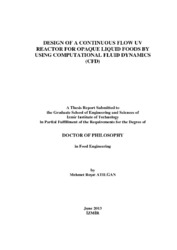Please use this identifier to cite or link to this item:
https://hdl.handle.net/11147/2966Full metadata record
| DC Field | Value | Language |
|---|---|---|
| dc.contributor.advisor | Ünlütürk, Sevcan | - |
| dc.contributor.author | Atılgan, Mehmet Reşat | - |
| dc.date.accessioned | 2014-07-22T13:48:40Z | - |
| dc.date.available | 2014-07-22T13:48:40Z | - |
| dc.date.issued | 2013-06 | - |
| dc.identifier.uri | http://hdl.handle.net/11147/2966 | - |
| dc.description | Thesis (Doctoral)--Izmir Institute of Technology, Food Engineering, Izmir, 2013 | en_US |
| dc.description | Includes bibliographical references (leaves: 140-158) | en_US |
| dc.description | xvii, 158 leaves | en_US |
| dc.description | Full text release delayed at author's request until 2016.06.19 | en_US |
| dc.description.abstract | UV-C radiation is usually applied as an alternative non-thermal process for clear liquid food products in order to achieve microbiologically safe and shelf stable products. The main objective of this Ph.D. study was to design a UV reactor inorder to provide efficient UV dose/intensity distribution to reach minimum 5 log microbial reduction in opaque liquid foods. For this purpose, a S-shaped, thin film, continuous flow UV reactor was designed and constructed. UV dose/intensity delivered in the UV system was measured and determined by means of biodosimetric, actinometric and computational fluid dynamics (CFD) methods. Inactivation performance of the UV reactor was assesed by using both clear and freshly squeezed opaque white grape juices. The number of spoilage yeast, lactic acid bacteria and E.coli K-12 (ATCC 25253) in opaque grape juice was reduced to 1.604, 4.133 and 5.431 log at UV dose levels of 247.302, 301.113 and 273.520 mJ/cm2 respectively. For clear grape juice samples inoculated with S.cerevisiae and E.coli K-12 (ATCC 25253), 6.498 and 5.986 log reductions were achieved at UV dose levels of 1001.618 and 577.245 mJ/cm2. The microbial shelf life of freshly squeezed grape juice was extended up to fourteen days which was two times longer compared to untreated samples at refrigerated conditions. The physicochemical properties of UV-C processed grape juice were also evaluated during storage. Although pH, total soluble content (Bix %) and total titratable acidity were not affected from UV treatment, significant changes observed in pH, turbidity, color properties, total soluble content (Brix %), total titratable acidity and ascorbic acid (Vitamin C) content during storage. | en_US |
| dc.language.iso | en | en_US |
| dc.publisher | Izmir Institute of Technology | en_US |
| dc.rights | info:eu-repo/semantics/openAccess | en_US |
| dc.subject.lcsh | Food--Microbiology | en |
| dc.subject.lcsh | Computational fluid dynamics | en |
| dc.title | Design of a Continuous Flow Uv Reactor for Opaque Liquid Foods by Using Computational Fluid Dynamics (cfd) | en_US |
| dc.type | Doctoral Thesis | en_US |
| dc.institutionauthor | Atılgan, Mehmet Reşat | - |
| dc.department | Thesis (Doctoral)--İzmir Institute of Technology, Food Engineering | en_US |
| dc.relation.publicationcategory | Tez | en_US |
| dc.identifier.wosquality | N/A | - |
| dc.identifier.scopusquality | N/A | - |
| item.openairecristype | http://purl.org/coar/resource_type/c_18cf | - |
| item.openairetype | Doctoral Thesis | - |
| item.languageiso639-1 | en | - |
| item.cerifentitytype | Publications | - |
| item.grantfulltext | open | - |
| item.fulltext | With Fulltext | - |
| Appears in Collections: | Phd Degree / Doktora | |
Files in This Item:
| File | Description | Size | Format | |
|---|---|---|---|---|
| 10003627.pdf | DoctoralThesis | 3.34 MB | Adobe PDF |  View/Open |
CORE Recommender
Page view(s)
332
checked on May 12, 2025
Download(s)
546
checked on May 12, 2025
Google ScholarTM
Check
Items in GCRIS Repository are protected by copyright, with all rights reserved, unless otherwise indicated.